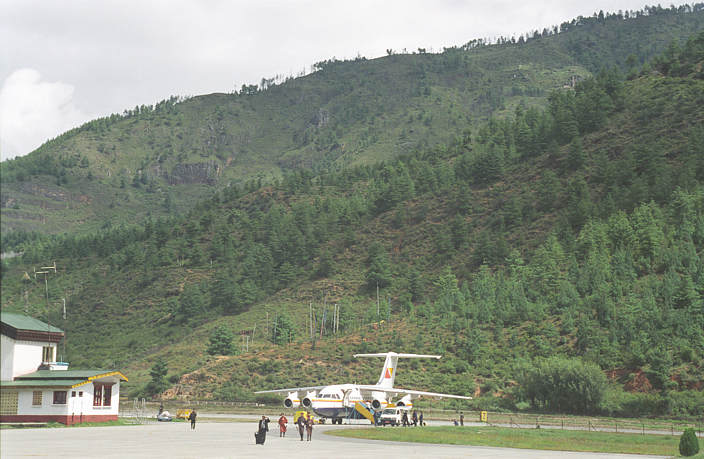
One can fly into Bhutan via one of the country's two nationalized jets.
The descent into the 7300 foot high Paro Valley is steep. The 4-engine
BAe146-100 skims over the mountain ridges, so it seemed on a clear day.
How they manage this in heavy rain is a mystery. The take-off and ascent is
also dramatic with the jet making tight circles to clear the mountains. After
3 revolutions, we were passing a few hundred feet over yet another set of homes
high in the mountains. (A large 2-engine 737-700 with winglets has successfully
been test flown in and out of Paro and might be purchased.) When you fly above
Bhutan, on a clear day you can see the Everest region rising higher than your
flight path in the distance. Closer in, there is a gleaming view of 28,169 foot
Mount Kanchenjunga (photo to be scanned and added at the end).
 Click on the griffon or the photo to continue. Scroll down for Bhutan 101.
Click on the griffon or the photo to continue. Scroll down for Bhutan 101.
Bhutan is an old and independent country, a bit larger than Switzerland (or two New Jerseys!).
It has sacred Himalayan peaks and thousands of smaller mountains and hills. If its terrain
could somehow be ironed out so that it had no wrinkles, it could be the size of Texas!
That's a wild guess to emphasize that there is no direct comparison for a square mile
of Bhutan with a square mile anywhere else.
Bhutan is a Buddhist country and a monarchy with a storied past, much of which has been
lost except in oral memory. Buddhist prayer flags and prayer wheels are set at many prominent
points. A deep issue is the role this Buddhism plays in the preservation of the country's integrity.
Bhutan is a forerunner in protecting its environment and culture. It has large designated National
Parks. Most all traditional and indigenous uses are permitted within these Parks. Wide swaths
of land between the Parks have been dedicated as wildlife corridors to keep the gene pools
strong and diverse. Fishing the pristine streams is taboo.
Bhutan is squeezed between the huge populations of India and China. Vast regions of the country
are seemingly uninhabited except by occasional travelers on the thin trails making their seasonal
rounds to markets, festivals, and to sacred places. In the high alpine regions to be shown here,
there are more yaks than people.
The year 2003 will close with there being approximately ¾ million people in Bhutan.
Some can be traced back to Nepal or Tibet. Some are Indians with temporary work visas.
A Mongolian bloodline runs through many of the people. Half of the population is children.
They receive a government sponsored education in schools in which English is often the
language of instruction. Rural children can live in boarding schools that run from April to
mid-November. Half of the population lives a day or more walk from the nearest road.
Most of the people are small-scale farmers or herders. There are the usual pressures
for this to change and for the young to crowd into the few cities.